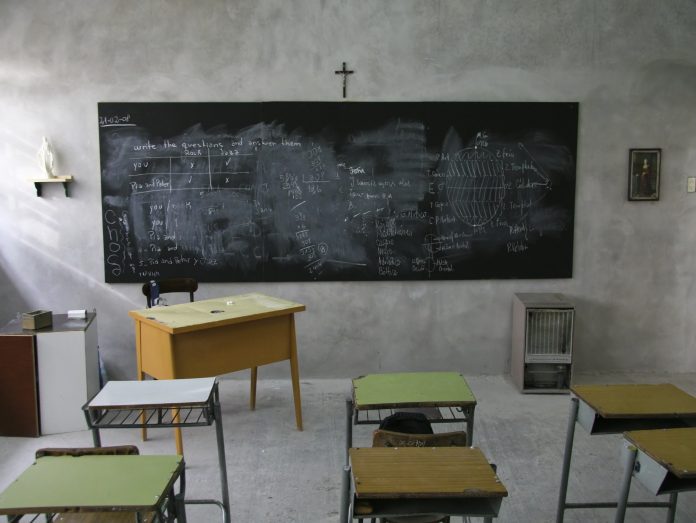
by Kate Ristow
For more ideas about different kinds of name tags, see the end of this article.
In many ways, catechesis is a lot like parenting. Although there are thousands of “how-to” books and articles filled with strategies and suggestions for being the best catechist ever, we often learn more through on-the-job training and trial and error.
Yet, there are a number of proven techniques that, when used consistently, lead to successful classroom sessions. Making these practices part of your normal, weekly routine frees you to focus on helping your students grow in faith.
Do Your Homework
No matter how well you know the doctrines of our faith or even if teaching is your chosen vocation, you have a lesson to plan every week. Trying to improvise or being unprepared to teach is asking for trouble.
Lesson planning involves five steps.
1. Reading the entire chapter: Study both the student lesson and the guide notes.
2. Charting your course: Choose the activities you will use to help your students learn and live the contents of the chapter. Today’s guides offer such a wealth of ideas that you must make choices.
3. Creating a thumbnail lesson plan: Write a mini-outline on an index card that you can glance at as you teach. Note the page numbers in your guide for each element. Better yet, use sticky tabs to mark the pages you need to refer to in your guide during the lesson. Your thumbnail plan is the essential GPS for your session.
4. Gathering the materials you need: Don’t wait until the last minute to find a favorite story to read, craft supplies that are not ordinarily stocked in your parish resource center, or a special item for the prayer table. Put all these supplies, along with your Catechist Guide, class list, and the folder where you keep memos and your Catechist Handbook, in a box with handles or a large canvas tote bag that you can grab and go on class day.
5. Requesting resources: Follow program procedures to arrange for worksheets to be duplicated and to request audio-visual equipment or supplies for your class. For example, you may want to use purple construction paper for an Advent project. If so, you may need to call the religious education office or complete and hand in a form a week in advance.
Arrive Early
You need to be in your classroom 20 to 30 minutes before the session begins to set up your teaching space: arranging items on the prayer table, laying out supplies, positioning desks. Factor in the time you’ll spend checking in at the religious education office, picking up your supply box, visiting with your catechetical leader, and reading his/her weekly memo. You’ll also want to greet other catechists, especially those who teach at your grade level. Catechesis is a shared mission. Comparing notes and reaching out to others is an important part of the process.
Greet Your Students at the Door
Always! This simple act of hospitality speaks volumes to the kids. It says that you recognize each one of them as individuals—not just children occupying the desks or chairs in your room. It gives you the opportunity to speak privately with each student, even if it’s just for a moment.
Greeting students at the door means so much when you call them by name, welcome them, and ask them how they are or how their week is going. It also is a visible sign that you are ready for them—not flitting around the room trying to get organized at the last minute—and that, together, you have an important mission: to learn more about what it means to be a disciple of Jesus.
Set Boundaries
Kids cannot learn and you cannot teach in an atmosphere of chaos. Rules are an important part of giving kids the structure they need. Although you want actively engaged students, kids need limits so that they can hear and respond to one another. Setting and enforcing rules makes this possible.
During your first class, invite students to brainstorm a list of rules governing their classroom behavior. Work with the kids to whittle down the list to as few regulations as possible. Your final list might look like this:
Treat everyone with kindness.
Listen while others are speaking.
Keep safety first.
Discuss with students what it means to keep each rule. For example, “Keep safety first” might mean acting safely, no running or throwing things in the classroom. Treating everyone with kindness includes not laughing at another student’s ideas or treating everyone as they would like to be treated.
Post the rules prominently on a poster in your classroom. Enforcing them is now your responsibility. Our editor here at CATECHIST, Kass Dotterweich, gave me a good mnemonic (a memory tickler) to use as a guide in responding to misbehavior. Kass calls it the ABCs of Discipline. Address the situation immediately; Be consistent; Claim your authority. In other words, insist that the children follow the rules! You don’t need to be mean or angry—in fact those emotions are counterproductive. Sometimes a gentle reminder works best, “Chris, please don’t interrupt. I want to hear what Ashley is saying.”
Over the years, I’ve found it very effective to go directly to misbehaving students and speak privately with them. There is no clearer way to indicate that you are aware of what’s going on and are prepared to take action. That’s more than half the battle!
Use a Seating Chart and Rotate Seating Frequently
Having students sit in assigned places helps you get to know them faster. On the day of your first session, place name tents on the students’ desks or at their places around tables. As students enter the room, introduce yourself and ask them to find their places. (A name tent is simply a piece of construction paper folded in half length-wise. Print the student’s name on both the front and the back, so it is visible from almost everywhere in the room.)
Name tags are an alternative idea—and a good one if you are having the students move around a lot during the session. However, junior high kids detest name tags and routinely affix them to the oddest places—the inside seam of their shirts, their back pockets, anywhere unconventional and often unmentionable! For younger kids, stick-on name tags are fine, although you almost always have to make new tags for each session until you know everyone’s name. They are also difficult to read from across the room.
Provide name tents in addition to any other type of name tag you or the students make. Collect them at the end of each session and store them in your supply box for use at the next class. (For additional name tag ideas, see the end of this article.)
Change the seating plan every couple of sessions. This helps to build community in your classroom. The kids will get to know one another more easily if they are seated near different classmates throughout the year.
Generate Discussion by Asking Open-Ended Questions
If you want students to express opinions about a topic, consider ways our faith can be lived, or share ideas with one another, ask questions that begin with the words why, how, and if. For example: Why does God give us the gift of free will? How can fifth-graders live the Corporal Works of Mercy? If you were at the Last Supper, how would you have responded to Jesus washing your feet?
It’s easier to ask comprehensive questions—questions that check the students’ understanding of a lesson. But comprehensive questions do not require kids to think about the meaning of the topic. Open-ended questions require thought. Be patient. Wait for students to think before jumping in to fill the silence. Then affirm the responses you get.
Get Students Working Together
Small-group work engages kids in the lesson. It also gives them a chance to interact with peers while they are learning.
Too often, we have one student at a time read aloud from the text while other students follow along. This was boring when you were a student and it’s still boring! Instead, you could divide the content portion of a chapter into parts and assign a segment to each group. The group’s task is to report back to the class on the two or three major points in their assigned section. Because you are thoroughly prepared, you will know if a group skips over an important element. You can insert the missed point or have the group discuss the text that was overlooked.
Other group activities might include making a poster that sums up a major teaching from the chapter or unit, writing a group prayer on the lesson theme, or brainstorming a list of specific and age-appropriate ways students might show love for their neighbor.
A word of caution: Group work raises the noise level in the classroom. Shut the door to avoid disturbing other classes; don’t allow yelling; and monitor the situation by walking around the room while the kids are working.
“Pray at Every Opportunity” (Ephesians 6:18)
Make prayer a priority in planning each of your lessons. One of our most important responsibilities as catechists is to help our students deepen their relationship with the Lord. Prayer is key to that process.
If you plan prayer for the end of your session, watch the clock and allow time for a meaningful experience. Move the kids out of their chairs to a standing or kneeling position near their desks or around the prayer table. Allow for a moment of silence before beginning any prayer experience.
Don’t be afraid to bless students or have them bless one another by tracing the sign of the cross on a classmate’s forehead. Invite them to exchange a sign of peace when appropriate. During the Easter season or a lesson on the Sacraments of Initiation or the Holy Spirit, use holy water to remind the children of their Baptism.
Vary the types of prayer you share together. Help students experience prayers of intercession, when we pray on behalf of others; prayers of praise that give glory to God; prayers of petition, in which we pray for our world, country, the Church, those who are sick and dying, and our own needs; and prayers of thanksgiving for the blessings in our lives, especially Jesus.
Allow time, space, and silence to meditate with your class. Try having the kids breathe deeply and quietly in and out as they slowly repeat the following: “Most Holy Spirit, lead me to Jesus.”
At least once during the year, review the meaning of the words to traditional prayers, especially the Our Father. We pray this prayer so often that the words can easily become meaningless. After making sure students understand what they are saying, pray the Lord’s Prayer s-l-o-w-l-y together.
Kate Ristow, Contributing Editor to CATECHIST, is National Catechetical Consultant for RCL Benziger. She has been involved in children’s religious education for over 25 years as a Catholic-school teacher and parish catechist.
Name tags
For kindergarteners or first graders, use the balloon pattern [CLICK HERE] to trace a name tag for each student on brightly colored construction paper. Letter each child’s name boldly on the front. Dress up the balloon by tying one or two thin, colorful strips of curling ribbon to the neck of the balloon name tag. Use straight pins or double-sided tape to secure the tag to the children’s shirts.
Use the crest pattern [CLICK HERE] for older students to make their own name tags. Trace the pattern on gold or bright yellow construction paper. Have kids use markers to write their names in the border at the top of the crest, then have them fill in the squares with information such as the following: favorite food; a hobby; the career or job they are most interested in; place they’d like to visit; a famous person they’d like to share a meal with; etc. After students complete their crests, invite each one to share the information with a partner or in a small group of three people. Then have them pin the crests to their shirts.
Copyright 2010, Bayard, Inc. All rights reserved. This article is protected by United States copyright and other intellectual property laws and may not be reproduced, rewritten, distributed, redisseminated, transmitted, displayed, published or broadcast, directly or indirectly, in any medium without the prior written permission of Bayard, Inc.
This article was written by the Catechist Staff and appeared in Catechist magazine, September 2010.
Image Credit: Shutter Stock 36076513




